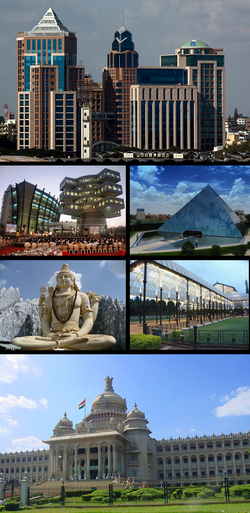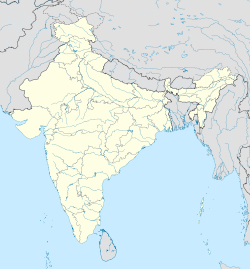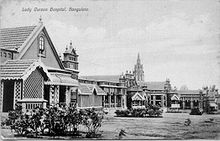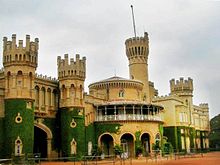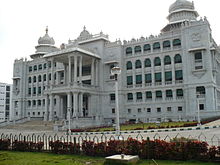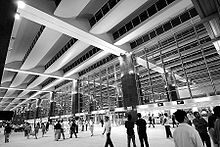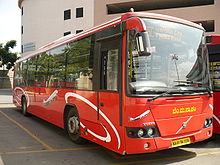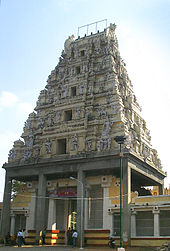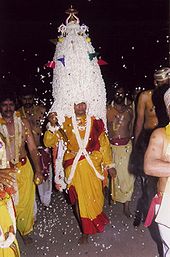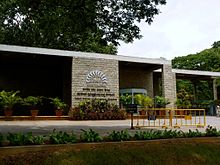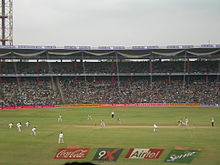
Bangalore
Background Information
SOS Children has tried to make Wikipedia content more accessible by this schools selection. Do you want to know about sponsoring? See www.sponsorachild.org.uk
| Bangalore Bengaluru |
|
|---|---|
| — Metropolis — | |
| Clockwise from top: UB City, Infosys, Glass house at Lal Bagh, Vidhana Soudha, Shiva statue, Bagmane Tech Park | |
|
|
|
| Coordinates: 12°58′N 77°34′E Coordinates: 12°58′N 77°34′E | |
| Country | India |
| State | Karnataka |
| Region | Bayaluseemē |
| District | Bangalore Urban |
| Established | 1537 |
| Government | |
| • Type | Mayor–Council |
| • Body | BBMP |
| • Mayor | D Venkatesh Murthy |
| • Commissioner | H.Siddaiah |
| Area | |
| • Metropolis | 741.0 km2 (286.1 sq mi) |
| Elevation | 920 m (3,020 ft) |
| Population (2011) | |
| • Metropolis | 8,474,970 |
| • Rank | 3rd |
| • Density | 11,000/km2 (30,000/sq mi) |
| • Metro | 8,499,399 |
| • Metro rank | 5th |
| • Metropolitan | 8,728,906 ( 5th) |
| Demonym | Bangalorean |
| Time zone | IST ( UTC+5:30) |
| Pincode(s) | 560 xxx |
| Area code(s) | 91-(0)80-XXXX XXXX |
| Vehicle registration | KA 01-05, KA 41, KA 50, KA 51, KA 53 |
| Spoken languages | Kannada, Hindi, Telugu, Tamil, Malayalam, Konkani |
| Ethnicity | Kannadigas, |
| Climate | BW ( Köppen) |
| Website | www.bbmp.gov.in |
Bangalore also rendered Bengaluru ['beŋgəɭuːɾu] is the capital of the Indian state of Karnataka. Located on the Deccan Plateau in the south-eastern part of Karnataka, Bangalore is India's third most populous city and fifth-most populous urban agglomeration. Bangalore is well known as a hub for India's information technology sector. It is among the top 10 preferred entrepreneurial locations in the world. As a growing metropolitan city in a developing country, Bangalore confronts substantial pollution and other logistical and socio-economic problems.
A succession of South Indian dynasties ruled the region of Bangalore until in 1537 AD, Kempé Gowdā—a feudatory ruler under the Vijayanagara Empire—established a mud fort considered to be the foundation of modern Bangalore. Following transitory occupation by the Marāthās and Mughals, the city remained under the Mysore kingdom, which is now a part of the Indian state of Karnataka. Bangalore continued to be a cantonment of the British and a major city of the Princely State of Mysore which existed as a nominally sovereign entity of the British Raj. Following the independence of India in 1947, Bangalore became the capital of Mysore state, and remained capital when the new Indian state of Karnataka was formed in 1956. With a Gross domestic product of $83 billion, Bangalore is listed 4th among the top 15 cities contributing to India's overall GDP.
Bangalore metropolitan expansion is an upcoming work of BBMP, the plan is to include Bangalore urban area, Bangalore Rural district, Ramnagara, Hoskote, to an extent beyond BIA[Bangalore International Airport], Hosur is also planned to be included in Bangalore Metropolitan area as the city takes over most of the part of the town.
Bangalore is home to many well-recognized colleges and research institutions in India. Numerous public sector heavy industries, technology companies, aerospace, telecommunications, and defence organisations are located in the city. Bangalore is known as the Silicon Valley of India because of its position as the nation's leading IT exporter. A demographically diverse city, Bangalore is a major economic and cultural hub and the second fastest growing major metropolis in India.
Etymology
The name Bangalore represents an anglicised version of the Kannada language name, Bengaḷūru [ˈbeŋɡəɭuːru]. The earliest reference to the name "Bengaluru" was found in a ninth century Western Ganga Dynasty stone inscription on a "vīra gallu" (ವೀರಗಲ್ಲು) (literally, " hero stone", a rock edict extolling the virtues of a warrior). In this inscription found in Begur, "Bengaluru" is referred to as a place in which a battle was fought in 890 CE. It states that the place was part of the Ganga Kingdom until 1004 and was known as "Bengaval-uru", the "City of Guards" in Halegannada (Old Kannada). An apocryphal, though popular, anecdote recounts that the 11th century Hoysala king Veera Ballala II, while on a hunting expedition, lost his way in the forest. Tired and hungry, he came across a poor old woman who served him boiled beans. The grateful king named the place "benda-kaal-uru" ( Kannada: ಬೆಂದಕಾಳೂರು) (literally, "town of boiled beans"), which eventually evolved into "Bengalūru".
On 11 December 2005, the Government of Karnataka announced that it had accepted a proposal by Jnanpith Award winner U. R. Ananthamurthy to rename Bangalore to Bengaluru. On 27 September 2006, the Bruhat Bengaluru Mahanagara Palike (BBMP) passed a resolution to implement the proposed name change. The Government of Karnataka accepted the proposal, and it was decided to officially implement the name change from 1 November 2006. However, this process has stalled due to delays in getting clearances from the Union Home Ministry.
History
The region of modern day Bangalore was part of several successive South Indian kingdoms. After centuries of the rule of the Western Gangas, the region was captured by the Cholas in 1024. In 1116 the Hoysala Empire overthrew the Cholas and extended its rule over the region. Modern Bangalore had its beginning in 1537 by a vassal of the Vijayanagara Empire, Kempé Gowda I, who built a mud-brick fort at the site that would become the central part of modern Bangalore. Kempé Gowda referred to the new town as his "gandubhūmi" or "Land of Heroes".
Within the fort, the town was divided into smaller divisions—each called a "pete" (IPA: [peːteː]). The town had two main streets—Chikkapeté Street, which ran east-west, and Doddapeté Street, which ran north-south. Their intersection formed the Doddapeté Square—the heart of Bangalore. Kempé Gowda's successor, Kempé Gowda II, built four towers that marked Bangalore's boundary. During the Vijayanagara rule, many Saints and Poets referred to Bangalore as "Devarāyanagara" and "Kalyānapura" or "Kalyānapuri" ("Auspicious City").
After the fall of the Vijayanagara Empire, Bangalore's rule changed hands several times. Kempé Gowda declared independence, then in 1638, a large Adil Shahi Bijapur army led by Ranadulla Khan and accompanied by Shāhji Bhōnslé defeated Kempé Gowda III, and Bangalore was given to Shāhji as a jagir (feudal estate). In 1687, the Mughal general Kasim Khan, under orders from Aurangzeb, defeated Ekoji I, son of Shāhji, and leased Bangalore to Chikkadevaraja Wodeyar (1673–1704), the ruler of Mysore kingdom. After the death of Krishnaraja Wodeyar II in 1759, Hyder Ali, Commander-in-Chief of the Mysore Army, proclaimed himself the de facto ruler of Mysore. The kingdom later passed to Hyder Ali's son Tipu Sultan.
Bangalore fort was captured by the British armies under Lord Cornwallis on 21 March 1791 during the Third Anglo-Mysore War and formed a centre for British resistance against Tipu Sultan. Following Tipu Sultan's death in the Fourth Anglo-Mysore War (1799), the British returned administrative control of the Bangalore "pētē" to the Maharaja of Mysore, choosing only to retain the Cantonment under their jurisdiction. The 'Residency' of Mysore State was first established in Mysore city in 1799 and later shifted to Bangalore in the year 1804. It was abolished in the year 1843 only to be revived in 1881 at Bangalore and to be closed down permanently in 1947, with Indian independence.
In the 19th century, Bangalore essentially became a twin city, with the "pētē", whose residents were predominantly Kannadigas, and the "cantonment" created by the British, whose residents were predominantly Tamils. Bangalore was hit by a plague epidemic in 1898 that dramatically reduced its population. New extensions in Malleswaram and Basavanagudi were developed in the north and south of the pētē. Telephone lines were laid to help co-ordinate anti-plague operations, and a health officer was appointed to the city in 1898. In 1906, Bangalore became one of the first cities in India to have electricity from hydel power, powered by the hydroelectric plant situated in Shivanasamudra. Bangalore's reputation as the Garden City of India began in 1927 with the Silver Jubilee celebrations of the rule of Krishnaraja Wodeyar IV. Several projects such as the construction of parks, public buildings and hospitals were instituted to improve the city. After Indian independence in August 1947, Bangalore remained in the new Mysore State of which the Maharaja of Mysore was the Rajapramukh (appointed governor).
Public sector employment and education provided opportunities for Kannadigas from the rest of the state to migrate to the city. Bangalore experienced rapid growth in the decades 1941–51 and 1971–81, which saw the arrival of many immigrants from northern Karnataka. By 1961, Bangalore had become the sixth largest city in India, with a population of 1,207,000. In the decades that followed, Bangalore's manufacturing base continued to expand with the establishment of private companies such as MICO (Motor Industries Company), which set up its manufacturing plant in the city. Bangalore experienced a growth in its real estate market in the 1980s and 1990s, spurred by capital investors from other parts of the country who converted Bangalore's large plots and colonial bungalows into multi-storied apartments. In 1985, Texas Instruments became the first multinational corporation to set up base in Bangalore. Other information technology companies followed suit and by the end of the 20th century, Bangalore had established itself as the Silicon Valley of India.
Geography
Bangalore lies in the southeast of the South Indian state of Karnataka. It is in the heart of the Mysore Plateau (a region of the larger Precambrian Deccan Plateau) at an average elevation of 900 m (2,953 ft). It is located at 12.97°N 77.56°E and covers an area of 741 km² (286 mi²). The majority of the city of Bangalore lies in the Bangalore Urban district of Karnataka and the surrounding rural areas are a part of the Bangalore Rural district. The Government of Karnataka has carved out the new district of Ramanagara from the old Bangalore Rural district.
The topology of Bangalore is flat except for a central ridge running NNE- SSW. The highest point is Vidyaranyapura Doddabettahalli, which is 962 m (3,156 ft) and lies on this ridge. No major rivers run through the city, though the Arkavathi and South Pennar cross paths at the Nandi Hills, 60 km (37 mi.) to the north. River Vrishabhavathi, a minor tributary of the Arkavathi, arises within the city at Basavanagudi and flows through the city. The rivers Arkavathi and Vrishabhavathi together carry much of Bangalore's sewage. A sewerage system, constructed in 1922, covers 215 km² (133 mi²) of the city and connects with five sewage treatment centres located in the periphery of Bangalore.
In the 16th century, Kempe Gowda I constructed many lakes to meet the town's water requirements. The Kempambudhi Kere, since overrun by modern development, was prominent among those lakes. In the earlier half of 20th century, the Nandi Hills waterworks was commissioned by Sir Mirza Ismail ( Diwan of Mysore, 1926–41 CE) to provide a water supply to the city. Currently, the river Kaveri provides around 80% of the total water supply to the city with the remaining 20% being obtained from the Thippagondanahalli and Hesaraghatta reservoirs of the Arkavathi river. Bangalore receives 800 million litres (211 million US gallons) of water a day, more than any other Indian city. However, Bangalore sometimes does face water shortages, especially during the summer season- more so in the years of low rainfall. A random sampling study of the Air Quality Index (AQI) of twenty stations within the city indicated scores that ranged from 76 to 314, suggesting heavy to severe air pollution around areas of traffic concentration.
Bangalore has a handful of freshwater lakes and water tanks, the largest of which are Madivala tank, Hebbal lake, Ulsoor lake and Sankey Tank. Groundwater occurs in silty to sandy layers of the alluvial sediments. The Peninsular Gneissic Complex (PGC) is the most dominant rock unit in the area and includes granites, gneisses and migmatites, while the soils of Bangalore consist of red laterite and red, fine loamy to clayey soils.
Vegetation in the city is primarily in the form of large deciduous canopy and minority coconut trees. Though Bangalore has been classified as a part of the seismic zone II (a stable zone), it has experienced quakes of magnitude as high as 4.5.
Climate
Bangalore experiences a tropical savanna climate ( Köppen climate classification Aw) with distinct wet and dry seasons. Due to its high elevation, Bangalore usually enjoys a more moderate climate throughout the year, although occasional heat waves can make things very uncomfortable in the summer. The coolest month is December with an average low temperature of 15.4 °C and the hottest month is April with an average high temperature of 32.8 °C. The highest temperature ever recorded in Bangalore is 38.9 °C(recorded in March 1931) and the lowest ever is 7.8 °C (recorded in January 1884). Winter temperatures rarely drop below 12 °C (54 °F), and summer temperatures seldom exceed 34–35 °C (<100 °F). Bangalore receives rainfall from both the northeast and the southwest monsoons and the wettest months are September, October and August, in that order. The summer heat is moderated by fairly frequent thunderstorms, which occasionally cause power outages and local flooding. The heaviest rainfall recorded in a 24-hour period is 179 millimetres (7.0 in) recorded on 1 October 1997.
| Climate data for Bangalore | |||||||||||||
|---|---|---|---|---|---|---|---|---|---|---|---|---|---|
| Month | Jan | Feb | Mar | Apr | May | Jun | Jul | Aug | Sep | Oct | Nov | Dec | Year |
| Record high °C (°F) | 32.1 (89.8) |
34.5 (94.1) |
37.0 (98.6) |
37.9 (100.2) |
37.8 (100) |
36.4 (97.5) |
28.1 (82.6) |
27.4 (81.3) |
28.2 (82.8) |
28.0 (82.4) |
27.0 (80.6) |
26.2 (79.2) |
37.9 (100.2) |
| Average high °C (°F) | 27.6 (81.7) |
30.2 (86.4) |
32.9 (91.2) |
34.1 (93.4) |
33.3 (91.9) |
29.4 (84.9) |
28.1 (82.6) |
27.5 (81.5) |
28.3 (82.9) |
28.0 (82.4) |
27.0 (80.6) |
26.2 (79.2) |
29.38 (84.89) |
| Daily mean °C (°F) | 21.3 (70.3) |
23.6 (74.5) |
26.1 (79) |
28.0 (82.4) |
27.4 (81.3) |
24.6 (76.3) |
23.9 (75) |
23.5 (74.3) |
23.9 (75) |
23.7 (74.7) |
22.2 (72) |
21.1 (70) |
24.11 (75.4) |
| Average low °C (°F) | 15.3 (59.5) |
17.2 (63) |
19.6 (67.3) |
21.8 (71.2) |
21.5 (70.7) |
20.0 (68) |
19.8 (67.6) |
19.6 (67.3) |
19.7 (67.5) |
19.4 (66.9) |
17.7 (63.9) |
16.0 (60.8) |
18.97 (66.14) |
| Record low °C (°F) | 10.6 (51.1) |
11.4 (52.5) |
13.9 (57) |
16.8 (62.2) |
17.2 (63) |
17.4 (63.3) |
17.0 (62.6) |
17.5 (63.5) |
16.8 (62.2) |
13.0 (55.4) |
11.3 (52.3) |
10.6 (51.1) |
10.6 (51.1) |
| Rainfall mm (inches) | 1.8 (0.071) |
7.9 (0.311) |
7.0 (0.276) |
40.0 (1.575) |
110.2 (4.339) |
89.1 (3.508) |
108.9 (4.287) |
142.5 (5.61) |
241.0 (9.488) |
154.5 (6.083) |
54.1 (2.13) |
17.5 (0.689) |
974.5 (38.367) |
| Avg. rainy days | 0.2 | 0.5 | 0.8 | 3.0 | 6.9 | 6.0 | 7.4 | 10.0 | 10.3 | 7.9 | 3.9 | 1.6 | 58.5 |
| % humidity | 60 | 52 | 45 | 51 | 60 | 72 | 76 | 79 | 76 | 73 | 70 | 68 | 65.2 |
| Mean monthly sunshine hours | 263.5 | 248.6 | 272.8 | 258.0 | 241.8 | 138.0 | 111.6 | 114.7 | 144.0 | 173.6 | 189.0 | 211.8 | 2,367.4 |
| Source #1: India Meteorological Department, NOAA (1971–1990) | |||||||||||||
| Source #2: HKO (sun only, 1971–1990) | |||||||||||||
Civic administration
| Bangalore City Important officials | |
|---|---|
| Municipal Commissioner: | Siddhiah |
| Chief Commissioner of Income Tax: | K Satya Narayana |
| Mayor: | D Venkatesh Murthy |
| Police Commissioner: | Jyothi Prakash Mirji |
The Bruhat Bengaluru Mahanagara Palike (BBMP, Greater Bangalore Municipal Corporation) is in charge of the civic administration of the city. It was formed in 2007 by merging 100 wards of the erstwhile Bangalore Mahanagara Palike, with seven neighbouring City Municipal Councils, one Town Municipal Council and 110 villages around Bangalore. The BBMP is run by a city council composed of 250 members, including 198 corporators representing each of the wards of the city and 52 other elected representatives, consisting of members of Parliament and the state legislature. Elections to the council are held once every five years, with results being decided by popular vote. Members contesting elections to the council usually represent one or more of the state's political parties. A mayor and deputy mayor are also elected from among the elected members of the council. Elections to the BBMP were held on 28 March 2010, after a gap of three and a half years since the expiry of the previous elected body's term, and the Bharatiya Janata Party was voted into power – the first time it had ever won a civic poll in the city.
Bangalore's rapid growth has created several problems relating to traffic congestion and infrastructural obsolescence that the Bangalore Mahanagara Palike has found challenging to address. The unplanned nature of growth in the city resulted in massive traffic gridlocks that the municipality attempted to ease by constructing a flyover system and by imposing one-way traffic systems. Some of the flyovers and one-ways mitigated the traffic situation moderately but were unable to adequately address the disproportionate growth of city traffic. In 2005 both the Central Government and the State Government allocated considerable portions of their annual budgets to address Bangalore's infrastructure. A 2003 Battelle Environmental Evaluation System (BEES) evaluation of Bangalore's physical, biological and socioeconomic parameters indicated that Bangalore's water quality and terrestrial and aquatic ecosystems were close to ideal, while the city's socioeconomic parameters (traffic, quality of life) scored poorly. The BBMP works with the Bangalore Development Authority (BDA) and the Agenda for Bengaluru Infrastructure and Development Task Force (ABIDe) to design and implement civic projects.
The Bangalore City Police (BCP) has six geographic zones, includes the Traffic Police, the City Armed Reserve, the Central Crime Branch and the City Crime Record Bureau and runs 86 police stations, including two all-women police stations. As capital of the state of Karnataka, Bangalore houses important state government facilities such as the Karnataka High Court, the Vidhana Soudha (the home of the Karnataka state legislature) and Raj Bhavan (the residence of the Governor of Karnataka). Bangalore contributes three members to the lower house of the Parliament of India, the Lok Sabha, and 28 members to the Karnataka State Assembly.
Electricity in Bangalore is regulated through the Bangalore Electricity Supply Company (BESCOM), while water supply and sanitation facilities are provided by the Bangalore Water Supply and Sewerage Board (BWSSB).
Pollution control
Bangalore generates about 3,000 tonnes of solid waste per day, of which about 1,139 tonnes are collected and sent to composting units such as the Karnataka Composting Development Corporation. The remaining solid waste collected by the municipality is dumped in open spaces or on roadsides outside the city. In 2008, Bangalore produced around 2,500 metric tonnes of solid waste, and increased to 5000 metric tonnes in 2012, which is transported from collection units located near Hesaraghatta Lake, to the garbage dumping sites. The city suffers significantly with dust pollution, hazardous waste disposal, and disorganized, unscientific waste retrievals. The IT hub, Whitefield region is the most polluted area in Bangalore.
Slums
According to a 2012 report submitted to the World Bank by Karnataka Slum Clearance Board, Bangalore has 862 slums from total of around 2000 slums in Karnataka. It is estimated that about 20% of Bangalore population reside in urban slums. The families living in the slum are not ready to move into the temporary shelters. 42% of the households migrated from different parts of India and 43% of the households had remained in the slums for over 10 years. The Karnataka Municipality, works to shift 300 families annually to newly constructed buildings. One third of these slum clearance projects lack basic service connections, 60% of slum dwellers lack complete water supply lines and share BWSSB water supply.
Economy
Bengaluru's ![]() 52,346 crore (US$9.53 billion) economy (2006–07 Net District Income) makes it one of the major economic centres in India, with the value of city's exports totalling
52,346 crore (US$9.53 billion) economy (2006–07 Net District Income) makes it one of the major economic centres in India, with the value of city's exports totalling ![]() 43,221 crore (US$7.87 billion) in 2004–05. With an economic growth of 10.3%, Bangalore is the second fastest growing major metropolis in India, and is also the country's fourth largest fast moving consumer goods (FMCG) market. The Forbes magazine considers the city as one of "The Next Decade's Fastest-Growing Cities". With a per capita income of
43,221 crore (US$7.87 billion) in 2004–05. With an economic growth of 10.3%, Bangalore is the second fastest growing major metropolis in India, and is also the country's fourth largest fast moving consumer goods (FMCG) market. The Forbes magazine considers the city as one of "The Next Decade's Fastest-Growing Cities". With a per capita income of ![]() 74,709 (US$1,359.7) in 2006–07, the city is the third largest hub for high net worth individuals and is home to over 10,000 dollar millionaires and about 60,000 super-rich people who have an investable surplus of
74,709 (US$1,359.7) in 2006–07, the city is the third largest hub for high net worth individuals and is home to over 10,000 dollar millionaires and about 60,000 super-rich people who have an investable surplus of ![]() 4.5 crore (US$1 million) and Rs. 50 lakh (US$ 91,000) respectively.
4.5 crore (US$1 million) and Rs. 50 lakh (US$ 91,000) respectively.
The headquarters of several public sector undertakings such as Bharat Electronics Limited (BEL), Hindustan Aeronautics Limited (HAL), National Aerospace Laboratories (NAL), Bharat Heavy Electricals Limited (BHEL), Bharat Earth Movers Limited (BEML) and HMT (formerly Hindustan Machine Tools) are located in Bangalore. In June 1972 the Indian Space Research Organisation (ISRO) was established under the Department of Space and headquartered in the city.
Bangalore is called the Silicon Valley of India because of the large number of information technology companies located in the city which contributed 33% of India's Rs. 144,214 crore (US$ 26 billion) IT exports in 2006–07. Bangalore's IT industry is divided into three main clusters — Software Technology Parks of India (STPI); International Tech Park, Bangalore (ITPB); and Electronics City. UB City, the headquarters of the United Breweries Group, is a high-end commercial zone. Infosys and Wipro, India's second and fourth largest software companies are headquartered in Bangalore, as are many of the global SEI-CMM Level 5 Companies.
The growth of IT has presented the city with unique challenges. Ideological clashes sometimes occur between the city's IT moguls, who demand an improvement in the city's infrastructure, and the state government, whose electoral base is primarily the people in rural Karnataka. The encouragement of high-tech industry in Bangalore, for example, has not favoured local employment development, but has, instead, increased land values and forced out small enterprise. The state has also resisted the massive investments required to reverse the rapid decline in intra-city transport which has already begun to drive new and expanding businesses to other centres across India. Bengaluru is a hub for biotechnology related industry in India and in the year 2005, around 47% of the 265 biotechnology companies in India were located here; including Biocon, India's largest biotechnology company.
Transport
Air
Bangalore is served by the Bengaluru International Airport ( IATA: BLR, ICAO: VOBL) which started operations from 24 May 2008. The city was earlier served by the HAL Airport which was India's fourth busiest airport. Kingfisher Airlines has its registered office in Bangalore. It is now the fourth busiest airport in India in terms of passenger traffic and the number of air traffic movements (ATMs) with about 280 per day. The airport is around 40 km from the city centre. The most hassle-free way to commute is by taxi. Meru cabs and Easy cabs have taxis present in the rank at the airport. There are also certain private cab companies.
Rail
A rapid transit system called the Namma Metro is being built. A 7 km stretch from Bayappanahalli to MG Road was opened to public on 20 October 2011. Once completed, this will encompass a 42.3 km (26.3 mi) elevated and underground rail network comprising 41 stations. It is expected to connect central locations in Bangalore to Devanahalli and the Chikballapur regions. This much-delayed project is the city’s primary response to the worsening intra-city transport infrastructure which has become a major deterrent to continued business growth.
Bangalore comes under Bangalore railway division of the South Western Railway zone of the Indian Railways. Bangalore City Railway station and Yesvantpur Junction connect it to the rest of the country through the Indian Railways. The Bangalore Rajdhani Express connects the city to New Delhi, the capital of India. Bangalore is also connected by rail to most cities in Karnataka, as well as Mumbai, Chennai, Coimbatore, Kolkata, Hyderabad, Indore, Belgaum, Hubli, Mysore, Bhagalpur, Tatanagar, Trivandrum, Bhopal, and other major cities in India. The sprawling Rail Wheel Factory is Asia's second largest manufacturer of Wheel & Axle for Railways and headquartered in Yelahanka, Bangalore.
Road
Buses operated by Bangalore Metropolitan Transport Corporation (BMTC) are an important and reliable means of public transport available in the city. While commuters can buy tickets on boarding these buses, BMTC also provides an option of a bus pass to frequent users. BMTC runs air-conditioned luxury buses on major routes, and also operates shuttle services from various parts of the city to the Bengaluru International Airport. The Karnataka State Road Transport Corporation operates 6,918 buses on 6,352 schedules, connecting Bangalore with other parts of Karnataka as well as other states. The main bus depots that KSRTC maintains are the Kempegowda Bus Station, locally known as "Majestic bus stand", where most of the out station buses ply from. Some of the KSRTC buses to Tamil Nadu and Andhra Pradesh ply from Shantinagar Bus Station, Satellite bus station in Mysore road and Baiyappanahalli satellite bus station. BMTC is the first metropolitan transport corporation to introduce air conditioned buses in India.
Three-wheeled, green and black auto-rickshaws, referred to as autos, are a popular form of transport. They are metered and can accommodate up to three passengers. Taxis, commonly called City Taxis, are usually available only on call. Taxis are metered and are generally more expensive than auto-rickshaws.
Demographics
| Population Growth | |||
|---|---|---|---|
| Census | Pop. | %± | |
| 1941 | 406,760 |
|
|
| 1951 | 778,977 | 91.5% | |
| 1961 | 1,207,000 | 54.9% | |
| 1971 | 1,654,000 | 37.0% | |
| 1981 | 2,922,000 | 76.7% | |
| 1991 | 4,130,000 | 41.3% | |
| 2001 | 5,101,000 | 23.5% | |
| 2011 | 8,425,970 | 65.2% | |
| Source: Census of India | |||
With an estimated population of 8.5 million in 2011, Bangalore is the third most populous city in India and the 18th most populous city in the world. Bangalore was the fastest-growing Indian metropolis after New Delhi between 1991–2001, with a growth rate of 38% during the decade. Residents of Bangalore are referred to as Bangaloreans in English and Bengaloorinavaru in Kannada.
The cosmopolitan nature of the city has resulted in the migration of people from other states to Bangalore, which has in recent years given rise to tensions between immigrants and locals. Scheduled Castes and Tribes account for 14.3% of the city's population. Various languages are spoken and understood namely Kannada, English, Tamil, Hindi and Telugu. Before 1991, Tamils were the single largest ethnic group in Bangalore. Still, more than 30% of the population are Tamils. A good number of Konkani speakers have settled in Bangalore since last century from Canara districts of Karnataka and Goa. Similarly, Marathi is spoken by a significant minority of the society.
According to the 2001 census of India, 79.4% of Bangalore's population is Hindu, roughly the same as the national average. Muslims comprise 13.4% of the population, which again is roughly the same as the national average, while Christians and Jains account for 5.8% and 1.1% of the population, respectively, double that of their national averages. Anglo-Indians also form a substantial group within the city. Women make up 47% of Bangalore's population. The city has a literacy rate of 89%. Roughly 10% of Bangalore's population lives in slums—a relatively low proportion when compared to other cities in the developing world such as Mumbai (50%) and Nairobi (60%). The 2008 National Crime Records Bureau statistics indicate that Bangalore accounts for 8.5% of the total crimes reported from 35 major cities in India.
Culture
Bangalore is known as the Garden City of India because of its greenery and the presence of many public parks, including the Lal Bagh and Cubbon Park.
The city celebrates its oldest festival, "Karaga Shaktyotsava" or Bangalore Karaga. Deepavali, the "Festival of Lights", transcends demographic and religious lines and is an important festival, along with the nine nights of Navratri. Other traditional Indian festivals such as Ganesh Chaturthi, Ugadi/ Gudi Padwa, Sankranthi, Eid ul-Fitr, and Christmas are also celebrated.
Bangalore is home to the Kannada film industry, which churns out about 80 Kannada movies each year. Bangalore also has a very active and vibrant theatre culture with popular theatres being Ravindra Kalakshetra and the more recently opened Ranga Shankara. The city has a vibrant English and foreign language theatre scene with places like Ranga Shankara and Chowdiah Memorial Hall leading the way in hosting performances leading to the establishment of the Amateur film industry. The diversity of cuisine is reflective of the social and economic diversity of Bangalore. Bangalore has a wide and varied mix of restaurant types and cuisines and Bangaloreans deem eating out as an intrinsic part of their culture. Roadside vendors, tea stalls, and South Indian, North Indian, Chinese and Western fast food are all very popular in the city. Udupi restaurants are very popular and serve predominantly vegetarian, regional cuisine.
In May 2012, Lonely Planet ranked Bangalore 3rd among the world's top 10 cities to visit.
Bangalore is also a major centre of Indian classical music and dance. Classical music and dance recitals are widely held throughout the year and particularly during the Ramanavami and Ganesha Chaturthi festivals.
Bangalore is sometimes called as the " Pub Capital of India" and the "Rock/Metal capital of India" because of its underground music scene and it is one of the premier places to hold international rock concerts.
Education
Until the early 19th century, education in Bangalore was mainly run by religious leaders and restricted to students of that religion. The western system of education was introduced during the rule of Mummadi Krishnaraja Wodeyar, when two schools were established in Bangalore. Subsequently, Wesleyan Mission established a school in 1851 and the Bangalore High School which was started by the Government in 1858.
In post-independent India, schools for young children are mainly based on the kindergarten form of education. Primary and secondary education in Bangalore is offered by various schools which are affiliated to one of the boards of education, such as the Secondary School Leaving Certificate (SSLC), ICSE, CBSE, IB and NIOS. Schools in Bangalore are either government run or are private (both aided and un-aided by the government). After completing their secondary education, students either attend Pre University (PUC) or continue High School in one of three streams – Arts, Commerce or Science. Alternatively, students may also enroll in Diploma courses. Upon completing the required coursework, students enroll in general or professional degrees in universities. The Bangalore University,established in 1886, provides affiliation to over 500 colleges, with a total student enrolment exceeding 300,000. The university has two campuses within Bangalore – Jnanabharathi and Central College.
Indian Institute of Science, which was established in 1909 in Bangalore, is the premier institute for scientific research and study in India. Nationally renowned professional institutes such as the National Centre for Biological Sciences (NCBS),Institute of bioinformatics and applied biotechnology [IBAB] National Institute of Design, Ahmedabad (NID), National Institute of Fashion Technology (NIFT), National Law School of India University (NLSIU), the Indian Institute of Management, Bangalore (IIM-B), the Indian Statistical Institute and International Institute of Information Technology, Bangalore (IIIT-B) are located in Bangalore. The city is also home to the premier mental health institution in India National Institute of Mental Health and Neuro Sciences (NIMHANS). Bangalore also has some of the best medical colleges in the country, like St. John's Medical College (SJMC) and Bangalore Medical College and Research Institute (BMCRI). The M. P. Birla Institute of Fundamental Research research institute has a branch located in Bangalore.
Sports
Cricket is the most popular sport in Bangalore. A significant number of national cricketers have come from Bangalore, including former Indian cricket team captains Rahul Dravid and Anil Kumble. Some of the other players who have represented India include Javagal Srinath, Gundappa Vishwanath, Syed Kirmani, E. A. S. Prasanna, Venkatesh Prasad, Sunil Joshi, Robin Uthappa, Vinay Kumar, Roger Binny and Abhimanyu Mithun. Many children play gully cricket on the roads and in the city's many public fields. Bangalore's international cricket stadium is the M. Chinnaswamy Stadium, which has a seating capacity of 55,000 and has hosted matches during the 1987 Cricket World Cup, 1996 Cricket World Cup and the 2011 Cricket World Cup. The Chinnaswamy Stadium is also the home of India's National Cricket Academy
The Indian Premier League franchise Bangalore Royal Challengers, the Premier Hockey League franchise Bangalore Hi-fliers, and the Karnataka Premier League franchisees Bangalore Brigadiers and Provident Bangalore are based in the city. India's Davis Cup team members, Mahesh Bhupathi and Rohan Bopanna also reside in Bangalore. The city hosts the Women's Tennis Association (WTA) Bangalore Open tournament annually. Beginning September 2008, Bangalore has also been hosting the Kingfisher Airlines Tennis Open ATP tournament annually. Bangalore is also home to the Bangalore Rugby Football Club (B.R.F.C)
Bangalore has a number of elite clubs, like Century Club, The Bangalore Golf Club, the Bowring Institute and the exclusive Bangalore Club, which counts among its previous members Winston Churchill and the Maharaja of Mysore. The Hindustan Aeronautics Limited SC is based in Bangalore. Other sports personalities from Bangalore include national swimming champion Nisha Millet, world snooker champion, Pankaj Advani and former All England Open badminton champion Prakash Padukone.
City based Clubs
| Club | Sport | League | Stadium | Span |
|---|---|---|---|---|
| Royal Challengers Bangalore | Cricket | IPL | M. Chinnaswamy Stadium | 2008 – |
| Bangalore Hi-fliers | Field hockey | PHL | Bangalore Hockey Stadium | 2005–2008 |
| Karnataka Lions | Field hockey | WSH | Bangalore Hockey Stadium | 2011 – |
| Karnataka Bulls | Volleyball | IVL | Kanteerava Indoor Stadium | 2011 – |
| HAL Bangalore | Football | I-League | Bangalore Football Stadium |
Sister cities
Bangalore is currently twinned with three sister cities:
| City | Region | Country |
|---|---|---|
| Minsk | ||
| San Francisco | ||
| Cleveland |
